Worried your eco-friendly stock will degrade before you use it? It’s a common fear. We provide durable compostable solutions and tips to keep them perfect.
To maximize the lifespan of compostable tableware before use, store it in cool, dry conditions, away from direct sunlight and extreme temperatures. Proper storage can extend shelf life significantly, often from 6 to 24 months depending on the material.
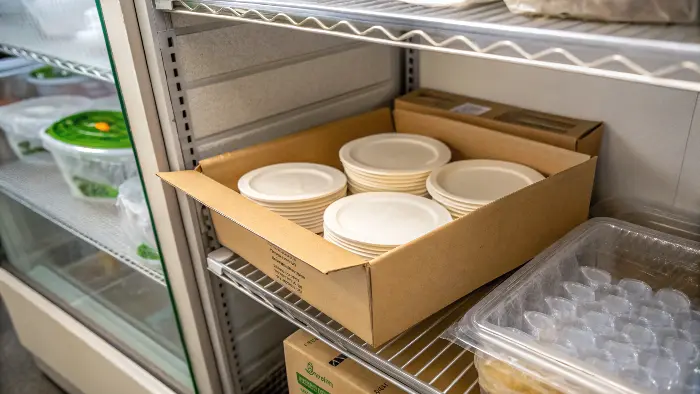
It’s a question I hear a lot from businesses making the switch to sustainable options. You invest in compostable tableware, which is fantastic, but then there’s this nagging worry: will it start breaking down in my storeroom? It’s a valid concern! After all, these products are designed to decompose. But the good news is, with a little know-how, you can keep them in tip-top shape until they’re ready for your customers. Think of it like fresh produce – you wouldn’t leave it out in the sun, right? Same principle, different material. Let’s explore how you can get the most out of your eco-investment.
How Long Do Compostable Plates Actually Last on the Shelf?
Are your compostable plates becoming brittle or misshapen in storage? This can be a real headache. We can help you understand their typical shelf life and how to extend it.
Compostable plates, typically made from bagasse, PLA, or palm leaf, can last from 6 to 24 months when stored correctly. Key factors include the specific material, packaging, and avoiding heat, moisture, and direct sunlight.
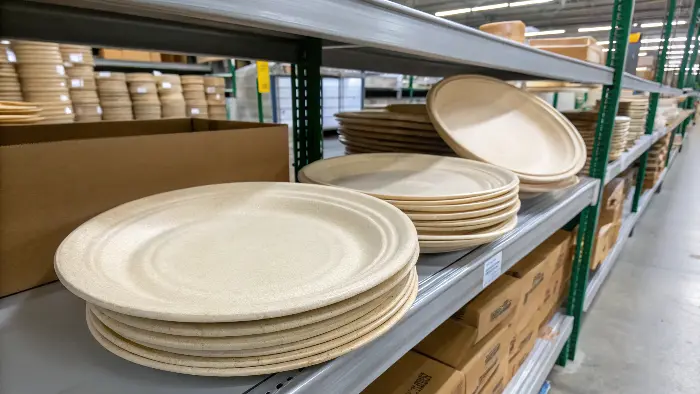
So, you’ve got a stack of compostable plates – maybe bagasse, maybe PLA, or even those lovely palm leaf ones. How long have you got before they start to, well, not be plates anymore? It’s not an exact science, like a "best before" date on a milk carton, but there are good guidelines. Generally, bagasse plates (made from sugarcane fiber) are pretty sturdy. If you keep them in a cool, dry place, away from direct sunlight, they can easily last 6 to 18 months. I once had a client, a small café owner, who stored her bagasse plates in a slightly damp back room. After a few months, they felt a bit soft. We talked about moving them to a drier spot, and her next batch was perfect for over a year! PLA plates, made from cornstarch or similar plant-based materials, can sometimes last a bit longer, say 12 to 24 months, but they are more sensitive to heat. If your storeroom gets too warm, PLA can warp. Palm leaf plates are very natural and look amazing, but their shelf life can be a bit more variable, usually around 6 to 12 months. They can dry out and become brittle or, if it’s too humid, could potentially develop mold. The original packaging they come in often helps protect them too, so try to keep them sealed until you need them.
Quick Guide: Compostable Plate Shelf Life & Storage
| Plate Material | Estimated Shelf Life (Ideal Conditions) | Key Storage Tip |
|---|---|---|
| Bagasse | 6-18 months | Keep dry; avoid extreme humidity fluctuations. |
| PLA | 12-24 months | Avoid heat sources; store below 35°C (95°F). |
| Palm Leaf | 6-12 months | Maintain moderate humidity; avoid direct light. |
| Wheat Straw | 6-18 months | Similar to bagasse; keep dry and cool. |
And What About the Shelf Life of Compostable Packaging Itself?
Is your compostable packaging becoming weak or tearing before its time? This undermines your sustainable efforts. We can shed light on how long different types should last.
Compostable packaging, like PLA films or bagasse containers, generally has a shelf life of 6 to 18 months. Proper storage away from heat, UV light, and moisture is crucial for maintaining its integrity before use.
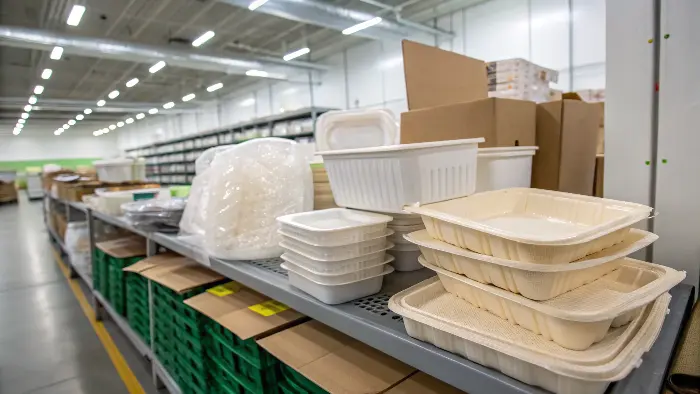
Compostable packaging is a broad category, from films and bags to sturdy containers. Their pre-use lifespan really depends on what they’re made of. For instance, PLA films or bags, often used for wrapping fresh produce or as liners, are quite sensitive. UV light and heat are their enemies, potentially making them brittle over time. You’d typically expect a shelf life of around 6 to 12 months for these if stored well. I always advise clients like Jacky, our packaging specialist friend in Canada, to be mindful of warehouse temperatures if they’re stocking up on PLA-based mailers. On the other hand, bagasse containers, like your takeaway boxes, are more robust, similar to the plates we just talked about. They can comfortably last 6 to 18 months in good storage. Then you have things like cellulose films (from wood pulp), which can be quite stable if kept dry. And don’t forget paper-based compostable packaging, perhaps with a PLA lining. The quality of the paper and the integrity of that lining play a big role. These can often last 12 to 24 months. The main takeaway? Know your material and treat it right! It’s not just about being eco-friendly; it’s about ensuring the product performs as expected when you finally use it.
Storage Best Practices for Different Packaging Types:
- PLA Films/Bags: Store in dark, cool conditions. Avoid stacking heavy items on top, which can cause creasing or stress.
- Bagasse Containers: Keep in their original cartons to prevent dust and moisture. Ensure good air circulation in the storage area.
- Paper-based (PLA-lined): Avoid damp environments that could weaken the paper fibers or compromise the PLA lining.
What’s the Real Lifespan of So-Called "Biodegradable Plastic" Before Use?
Confused by "biodegradable plastic" claims and their actual shelf stability? Many products mislead. We focus on truly compostable plastics and their reliable pre-use lifespan.
True compostable plastics like PLA, CPLA, or PBAT blends typically have a pre-use shelf life of 6 to 24 months. "Biodegradable" is a vague term; always look for compostability certifications for reliable end-of-life.
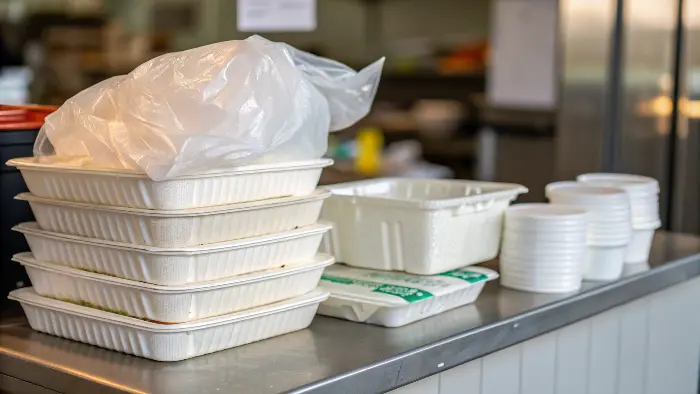
Ah, the term "biodegradable plastic" – it’s a bit of a minefield, isn’t it? I’ve seen so many businesses, and consumers too, get confused by this. The important thing to understand is that "biodegradable" on its own doesn’t mean much without context. Some plastics labeled "biodegradable" might just break down into smaller plastic pieces (microplastics!), or they might require very specific industrial conditions that rarely exist. That’s why at Ecosourcecn, we really focus on certified compostable plastics. These are materials like PLA (polylactic acid), CPLA (crystallized PLA), and blends like PBAT (polybutylene adipate terephthalate), which are designed to break down completely into natural elements in a composting environment.
Now, for their shelf life before you use them:
- PLA and CPLA: These are probably the most common. Stored correctly (cool, dry, out of direct sun), they can last 6 to 24 months. CPLA, being heat-treated, is generally more stable at slightly higher storage temperatures than standard PLA.
- PBAT: This is often blended with PLA to make products more flexible and to help them compost more readily. Its shelf life is usually in a similar range, around 6 to 18 months, depending on the specific blend and storage.
The manufacturing quality and any additives used can also influence this. But the key is, these materials are designed to be stable for a reasonable period before they encounter the conditions that trigger decomposition. It’s not like they’ll crumble in your hands after a few weeks!
Why "Biodegradable" Isn’t Always "Eco-Friendly"
It’s worth a quick note on things like "oxo-degradable" plastics. These contain additives that cause them to fragment over time when exposed to oxygen and UV light. Sounds good, but they often just create microplastics and aren’t suitable for composting. Always look for certifications like BPI or TÜV Austria’s "OK compost" logos.
Once Used, How Long Does It Take for Compostable Containers to Actually Decompose?
Wondering if your compostable containers truly break down as promised? The decomposition timeline is key. We explain what to expect from industrial and home composting.
Compostable containers typically decompose within 90-180 days in an industrial composting facility. In a home compost bin, it can take significantly longer, from 6 months to 2 years, depending on the material and conditions.
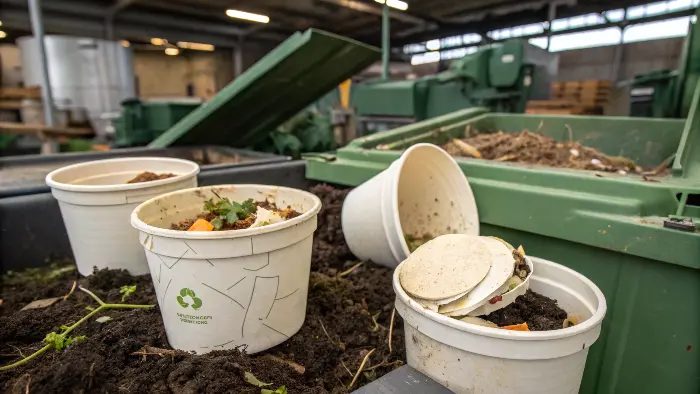
Okay, so we’ve talked about keeping your compostable containers in good shape before use. But what happens after they’ve served their purpose? This is where the "compostable" part really comes into play. Understanding this end-of-life process helps you choose the right products and set correct expectations for disposal.
There are mainly two scenarios:
1. Industrial Composting: This is the ideal environment. These facilities maintain high temperatures (around 55-70°C or 130-160°F), controlled moisture, and have a rich microbial population. For products certified compostable (like by BPI in North America or TÜV Austria in Europe), they are designed to break down significantly within 90 to 180 days under these conditions. This applies to materials like PLA, CPLA, and bagasse.
2. Home Composting: This is a bit different. Home compost piles or bins usually don’t reach the same high, consistent temperatures as industrial facilities. So, decomposition takes longer. For materials like bagasse or wheat straw, they can break down reasonably well in a well-managed home compost over 6 to 12 months, sometimes longer. Standard PLA, however, struggles in typical home compost conditions because it needs that higher heat to really get going. Some newer PLA blends or materials like PHA are certified "OK compost HOME," meaning they can break down in home systems, but it will still likely take 6 months to 2 years.
It’s super important for businesses, like Jacky’s eco-conscious brand, to communicate this. Just putting a "compostable" item in a landfill doesn’t help much, as landfills often lack the oxygen and conditions needed for proper decomposition. Access to appropriate composting facilities is key!
Composting Timelines: A Quick Comparison
| Composting Type | Typical Timeframe | Suitable Materials (Examples) | Key Factors for Success |
|---|---|---|---|
| Industrial Composting | 90-180 days | PLA, CPLA, Bagasse, Certified Blends | High heat, moisture, microbes, aeration |
| Home Composting | 6 months – 2 years+ | Bagasse, Wheat Straw, "OK compost HOME" certified items | Pile management, material type, C:N ratio |
Conclusion
Maximizing compostable tableware’s pre-use life is simple: store cool, dry, and dark. Understanding this, and their end-of-life, empowers sustainable choices. We’re here to guide you.


